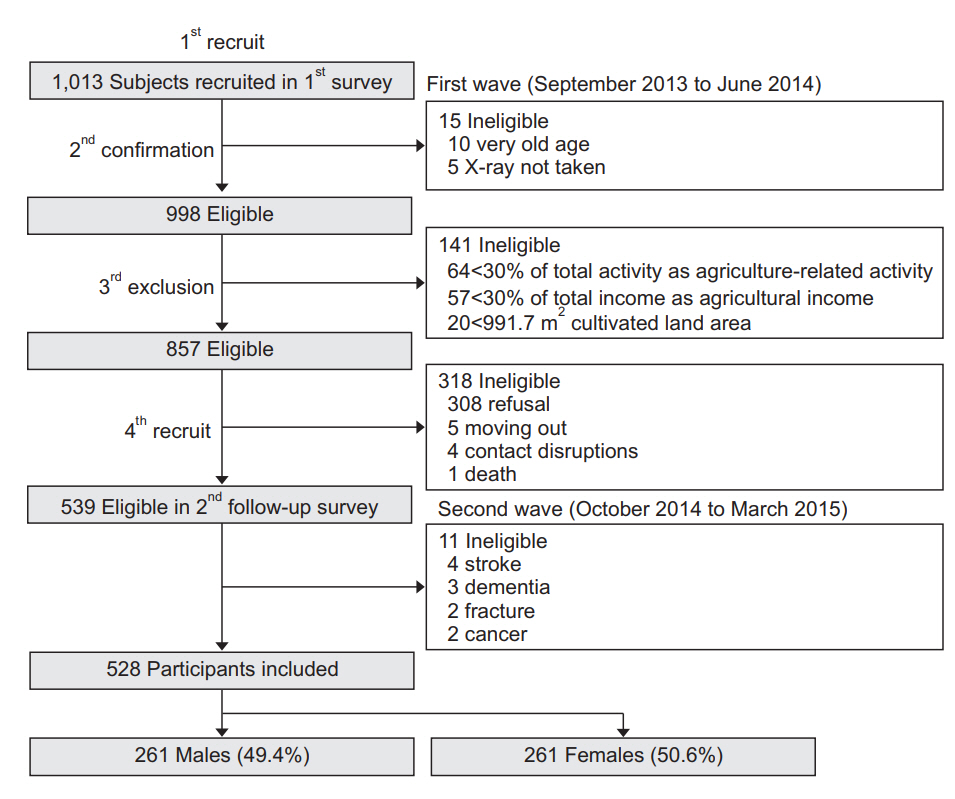2. Bohannon RW. Hand-grip dynamometry predicts future outcomes in aging adults. J Geriatr Phys Ther 2008;31:3-10.


3. Chandra AM, Ghosh S, Iqbal R, Sadhu N. A comparative assessment of the impact of different occupations on workers’ static musculoskeletal fitness. Int J Occup Saf Ergon 2007;13:271-8.


5. Hossain MG, Zyroul R, Pereira BP, Kamarul T. Multiple regression analysis of factors influencing dominant hand grip strength in an adult Malaysian population. J Hand Surg Eur Vol 2012;37:65-70.


7. Confortin SC, Barbosa AR. Factors associated with muscle strength among rural community-dwelling older women in Southern Brazil. J Geriatr Phys Ther 2015;38:162-8.


11. American Society of Hand Therapists. Clinical assessment recommendations. Indianapolis: American Society of Hand Therapists; 1981.
12. Cho MJ, Kim KH. Use of the Center for Epidemiologic Studies Depression (CES-D) scale in Korea. J Nerv Ment Dis 1998;186:304-10.


13. Sohn SI, Kim DH, Lee MY, Cho YW. The reliability and validity of the Korean version of the Pittsburgh Sleep Quality Index. Sleep Breath 2012;16:803-12.


14. Lee DY, Lee KU, Lee JH, Kim KW, Jhoo JH, Kim SY, et al. A normative study of the CERAD neuropsychological assessment battery in the Korean elderly. J Int Neuropsychol Soc 2004;10:72-81.


18. Bot AG, Mulders MA, Fostvedt S, Ring D. Determinants of grip strength in healthy subjects compared to that in patients recovering from a distal radius fracture. J Hand Surg Am 2012;37:1874-80.


21. Vardar-Yagli N, Saglam M, Savci S, Inal-Ince D, Calik-Kutukcu E, Arikan H, et al. Impact of sleep quality on functional capacity, peripheral muscle strength and quality of life in patients with chronic obstructive pulmonary disease. Expert Rev Respir Med 2015;9:233-9.


22. Watson AM. Sleep and athletic performance. Curr Sports Med Rep 2017;16:413-8.


23. Kim M, Yoshida H, Sasai H, Kojima N, Kim H. Association between objectively measured sleep quality and physical function among community-dwelling oldest old Japanese: a cross-sectional study. Geriatr Gerontol Int 2015;15:1040-8.


25. Chen HC, Hsu NW, Chou P. The Association between sleep duration and hand grip strength in communitydwelling older adults: the Yilan study, Taiwan. Sleep 2017;40:zsx021.

26. Mohan V, Shamsaimon NS, Japri MB, Yasin NE, Henry LJ, Othman IR. Fore arm circumference and hand length predicts maximal hand grip strength among Malaysian population. Middle-East J Sci Res 2014;21:634-9.
29. Williams P, Lord SR. Effects of group exercise on cognitive functioning and mood in older women. Aust N Z J Public Health 1997;21:45-52.


33. Goldspink G. Loss of muscle strength during aging studied at the gene level. Rejuvenation Res 2007;10:397-405.


34. Kostka T, Arsac LM, Patricot MC, Berthouze SE, Lacour JR, Bonnefoy M. Leg extensor power and dehydroepiandrosterone sulfate, insulin-like growth factor-I and testosterone in healthy active elderly people. Eur J Appl Physiol 2000;82:83-90.


35. Orsatti FL, Nahas EA, Maesta N, Nahas-Neto J, Burini RC. Plasma hormones, muscle mass and strength in resistance-trained postmenopausal women. Maturitas 2008;59:394-404.


36. Kalmijn S, Janssen JA, Pols HA, Lamberts SW, Breteler MM. A prospective study on circulating insulinlike growth factor I (IGF-I), IGF-binding proteins, and cognitive function in the elderly. J Clin Endocrinol Metab 2000;85:4551-5.


37. Wu AW, Yasui Y, Alzola C, Galanos AN, Tsevat J, Phillips RS, et al. Predicting functional status outcomes in hospitalized patients aged 80 years and older. J Am Geriatr Soc 2000;48(5 Suppl): S6-15.


38. Rosen CJ. Serum insulin-like growth factors and insulin-like growth factor-binding proteins: clinical implications. Clin Chem 1999;45(8 Pt 2): 1384-90.










